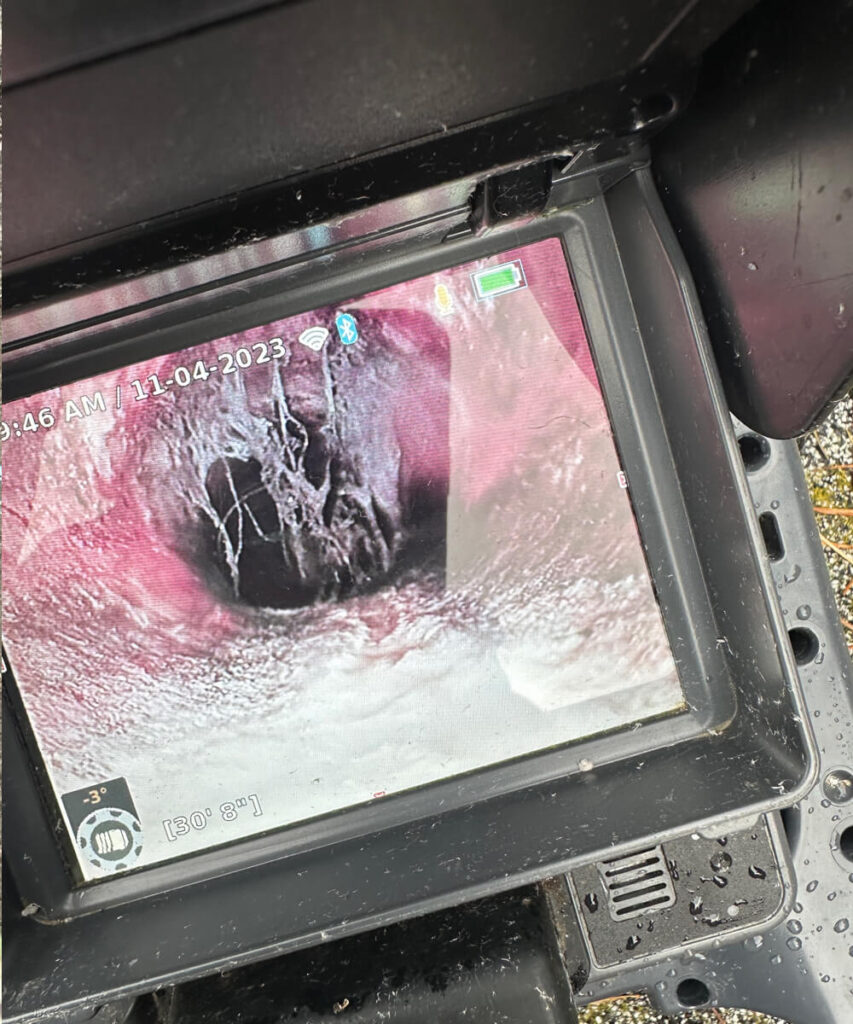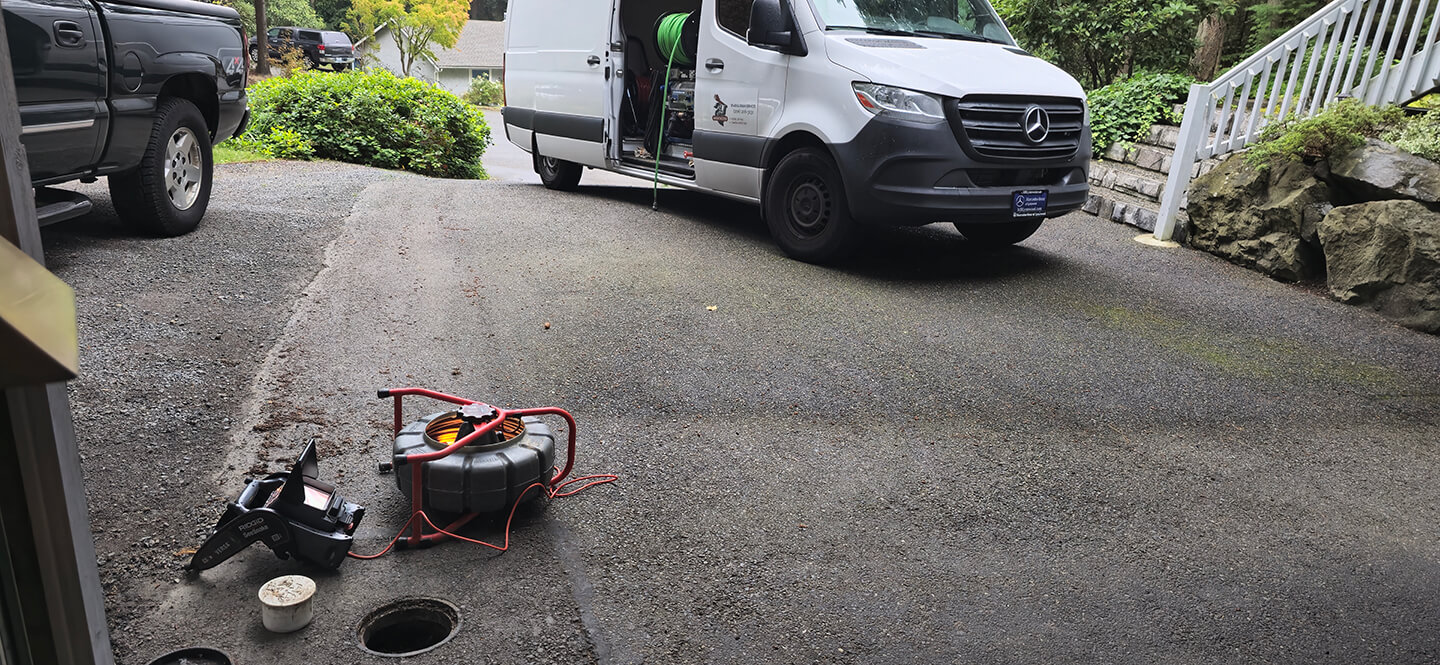A tiny waterproof sewer camera has completely transformed the way sewer problems are diagnosed and repaired. Instead of digging up yards, breaking concrete, or guessing where a blockage might be, modern camera inspections give technicians a clear, real-time view inside the line. This article explains how sewer cameras work, why they prevent costly excavation, how they enable trenchless repairs, and includes a real KnightRooter case study showing how one quick camera inspection saved a homeowner thousands of dollars in unnecessary digging.
The Hidden Disaster Under Your Lawn
Most homeowners never think about their sewer line until raw sewage bubbles up in the shower or the yard turns into a swamp overnight.
By then, the damage is obvious—and the traditional fix is painful: heavy equipment tearing up landscaping, driveways, or even floors.
But a single piece of modern plumbing technology has quietly revolutionized the industry: a tiny, waterproof, self-illuminated camera that travels through pipes and shows technicians exactly what’s wrong—before a single shovel hits the ground.
Why Sewer Lines Fail (and Stay Hidden)
Common culprits include:
- Tree roots searching for water (the #1 enemy of underground pipes)
- Decades of grease and cooking oil solidifying into rock-hard blockages
- Pipe bellies (sagging sections that trap waste)
- Cracks, offsets, or complete collapses from ground shifting
- Foreign objects (wipes, toys, construction debris)
Because everything happens underground and out of sight, guessing the location and severity used to be the only option.
The Old Way: Dig First, Ask Questions Later
Before sewer cameras became standard, the process was brutal:
- Guess where the problem might be
- Bring in an excavator and tear open the yard
- Hope you guessed right
- Repair what you find (and often discover the real issue is 20 feet farther)
- Fill the hole, re-pour concrete, re-sod the lawn
The result? Days or weeks of disruption, destroyed landscaping, and bills that kept climbing with every “surprise” uncovered.

How a Tiny Waterproof Camera Changed Everything
Today’s professional sewer inspection cameras are engineering marvels in miniature:
- Diameter as small as ¾ inch – easily passes through standard cleanouts
- High-intensity LED lighting that works in complete darkness
- Self-leveling heads that keep the picture upright no matter how the cable twists
- 512 Hz sonde transmitters so technicians can pinpoint the camera’s exact location above ground
- Live HD video streamed to a rugged tablet or recorder
The technician simply inserts the camera through an existing cleanout or toilet and pushes it through the line while watching everything in real time. No digging. No mess. Just pure diagnostic accuracy.
Real KnightRooter Case Study: From Panic to Precision
A few months ago, a KnightRooter crew responded to a desperate call from a family in [Your City]. Every drain in the house was backing up, and sewage was pooling in the downstairs bathtub. The homeowner was convinced the entire main line had collapsed and was already preparing for a full yard excavation.
Our master plumber accessed the exterior cleanout and fed the camera 48 feet into the line. Within minutes the screen revealed the truth: a massive root ball had completely choked the pipe at one specific joint—but the rest of the 60-year-old clay pipe was in surprisingly good condition.
Instead of digging up the entire front yard, the crew opened a single 4×4-foot hole directly above the blockage, removed the roots, replaced just 6 feet of damaged pipe, and relined the joint. The job was finished the same afternoon.
The lawn stayed intact, the driveway was untouched, and the family avoided what they feared would be a catastrophic repair.
Targeted Repairs vs. Blind Excavation
When you can see the problem with absolute precision, three game-changing things happen:
- You dig only where you need to (often just a small access point)
- You repair only the damaged section instead of replacing everything “just in case”
- You preserve healthy sections of pipe that still have decades of life left
That single change routinely turns five-figure jobs into far more manageable projects.
How Camera Data Enables True Trenchless Technology
In many cases, the camera reveals that the pipe structure is still sound—only the interior surface is damaged or infiltrated by roots. This is where cured-in-place pipe (CIPP) lining shines:
- A flexible, epoxy-soaked liner is inserted through the cleanout
- It’s inflated and hardened with hot water or UV light
- The result is essentially a new pipe inside the old one—no excavation required
This method is only possible when a camera has already confirmed the pipe can support a liner. Without that visual proof, plumbers have no choice but to recommend full replacement.
Warning Signs You Need a Sewer Camera Inspection Now
Don’t wait for a total backup. Call for a camera scope if you notice:
- Multiple slow-running drains at once
- Gurgling sounds from toilets or drains
- Sewage odors in the basement or yard
- Unusually lush or soggy patches of grass over the sewer line
- Recurrent clogs despite snaking
The earlier the camera goes in, the smaller (and less expensive) the fix usually is.
Why DIY or Rental Cameras Are a Risky Gamble
Yes, you can rent a sewer camera at some big-box stores, but experienced plumbers strongly discourage it:
- Interpreting footage accurately takes years of training (roots can look exactly like grease or offset joints)
- Cheap rental units often get stuck—retrieval can cost thousands
- Professional cameras include locating sondes; most rentals do not
One misread frame can lead to digging in the wrong spot and turning a simple repair into a nightmare.
Conclusion: Visibility Is the Ultimate Money-Saver
A 2-centimeter camera has become one of the most powerful cost-saving tools in modern plumbing. It eliminates guesswork, prevents unnecessary excavation, and opens the door to truly trenchless solutions.
If you’re experiencing even minor sewer symptoms, don’t gamble on the old “dig and hope” method. Schedule a professional sewer camera inspection today and turn a potential disaster into a quick, targeted fix.
KnightRooter – Your Trenchless & Camera Inspection Experts
Visit knightrooter.com to book online.
Explore More Resources
For more information on sewer line maintenance and repair, visit our service pages:
- Camera Inspection Everett
- Camera Inspection Edmonds
- Camera Inspection Seattle
- Camera Inspection bothell
- Camera Inspection Kirkland
- Camera Inspection Lynnwood
- Camera Inspection Woodinville
- Camera Inspection Snohomish
- Camera Inspection Bellevue
AFQ
1. Will the camera damage my pipes?
No. The head is smooth and flexible, and technicians advance it slowly under controlled pressure.
2. How long does a sewer camera inspection take?
Usually 30–60 minutes for a typical residential line.
3. Can it inspect every type of pipe?
Yes—from 2-inch branch lines to 12-inch municipal mains.
4. What if the blockage is extremely deep?
Professional push cameras can travel 200+ feet when needed.
5. Do you record the video for the homeowner?
Absolutely. KnightRooter provides a full digital recording and written report with time-stamped findings.
6. Is a second inspection done after the repair?
Always. We record “before” and “after” footage to prove the line is completely clear.
For professional and fast drain cleaning Bothell, drain cleaning Seattle, and drain cleaning Bellevue, contact KnightRooter. Our team is ready to provide the best solutions for your drain issues.





No comment yet, add your voice below!